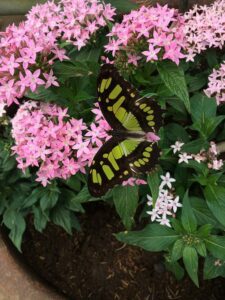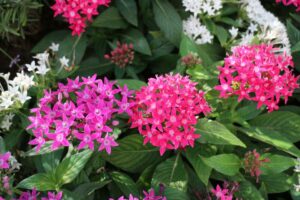Tips to Propagate Pentas Plant

Bring lots of colors into your spring and summer gardens with Pentas, these tropical perennial beauties also go by the common name the Egyptian star. Pentas are native to tropical regions of Africa and southern Asia, thriving best in U.S. Department of Agriculture plant hardiness zones 9 through 11. If you are planning on installing a wildlife garden then Pentas are the perfect fit, these plants will attract butterflies and hummingbirds to your garden area.
Pentas produces an abundance of star-like flowers that comes in an array of colors which are dark pink, white, red, purple, rose, lavender, and lipstick. Why you should also consider including Pentas in your spring and summer gardens is they are heat and drought-resistance. They can go a long time without water and still look great even though it’s best to keep them well-watered during times of drought. If you missed our discussion on Penta’s plant care and deading heading Pentas you can read about it here.
Below however we will be taking a closer look at how to populate your garden area with Pentas without having to spend those extra bucks. If this sounds like you then continue reading to see how this is done.
Propagating Pentas
1. Before you get started with propagating your Pentas prepare the potting medium, to do this choose the number of plastic pots you will need for your cuttings to grow. 6-inch plastic pots or containers with drain holes will do or if preferred the containers can be a bit larger provided there are drain holes.
Next, fill each pot/container with the potting medium, a good potting medium can be purchased from your plant nursery or garden center. If you have good garden soil on hand you can use this as well, ensure however that the soil is sterilized.
- There are several ways to sterilize the soil, one way is to put the soil in a bowl followed by pouring hot water thoroughly and slowly over the soil, this process will kill any soil-inhabiting insects along with their eggs.
- When sterilizing soil in the microwave make sure you are using microwavable containers, please, please, please, do not use foil paper which is so dangerous. Place moist soil in a microwavable container and heat the soil for about 90 seconds
- Soil can also be sterilized in your oven, place about 4 inches of soil in an oven-safe container such as a metal baking or glass pan. Once you have placed your soil in the pan cover with foil paper. Heat your oven to 180 to 200 degrees F. (82-93.) for about 30 minutes, after 30 minutes remove the pan from the oven and allow it to cool before the planting procedure.

2. You will also need a rooting hormone preferably the powdered form, a rooting hormone will stimulate and encourage root growth from your cuttings.
3. When selecting cuttings choose lateral softwood shoots that spring from a leader branch, with a sharp knife or hand pruner remove or cut the lateral stem from the leader. From the growing tip make the cut about 1-inch below the second leaf node, plant leaf nodes are swellings or bumps where stems or new leaves emerge or grow from on a plant.
So it’s good to local these nodes before you make the cut because what you don’t want is to cut into them which can cause server damage hindering plant growth from this area.
4. Once you’re ready to start planting remove the cuttings from the paper towel, next remove the two lower leaves from the cutting. The end of the cutting that is to be inserted into the soil make a small cut because this is the end where the new roots will emerge.
Once that is done dip that seam end that received the small cut in water, which will help the rooting hormone to stick, once this is done dip that seam end in the rooting hormone.
5. With your finger, a pencil, or some other object that’s the size of a pencil make a hole in the soil or potting medium, now that seam end that has the rooting hormone insert in the hole bout 1/2 inch below the soil surface.
6. Make sure that each stem cutting is erected or standing straight and with your next hand frim the soil around it by gently pressing.
7. Keep the cuttings in a cool place that receives bright indirect sunlight, the soil should also be kept evenly moist not waterlogged or saturated which can lead to root rot.
8. Within a few weeks Pentas cuttings will develop a root system, a sure sign to test if your cuttings have taken roots are gently tugging on the stem, if there is some resistance this a good sign that your cutting has taken roots. Another sign is top growth or new sets of leaves that emerges.
Additional information on Propagating Pentas
When taking cuttings the best time of the day to perform this procedure is during the morning hours when it’s still cool, taking cuttings in the heat of the day can cause cuttings to (moisture loss) dry out. If you take your cuttings early but plan on planting them a few hours later then wrap each cutting in a paper towel that’s moistened with water. Place cuttings in a plastic container and out of the sun but in an area that’s heavily shaded.
The final word on propagating pentas
Populating our garden with Pentas is that easy, all it takes is some know-how and you have come to the right place. Just follow this guide and you will be well on your way to good success. I believe that these garden beauties are worth the small amount of work and time as you see the results you’re looking for filling your garden with an array of beautiful flowering plants, go for it. You will be so happy that you did.
About the author
Norman loves being in the garden, both at home and for his job....
he is 'Natures Little helper' being outdoors, growing his vegetables and flowers from an early age.
Now having spent over 22 years in the profession he want to give some of his knowledge to others...
his vast array of hints and tips you will find scattered over this site will help you no end growing plants in your garden.
